Effective Separation and Hydrocarbon Accounting in Water-in-Oil Emulsion Through Demulsification Using Formulated Plant Extracts
| Received 21 Oct, 2024 |
Accepted 30 Jan, 2025 |
Published 31 Jan, 2025 |
Background and Objective: Crude oil emulsions have been one of the major problems of the petroleum industry, as oil combines with water during production. This work focused on resolving water-in-oil emulsion using plant-based formulated demulsifiers made from cashew leaf (Anacardium occidentale B-1) and Moringa leaf extract (Moringa oleifera, C-1) and respective additives. Materials and Methods: The Soxhlet extraction technique with absolute ethanol as the solvent was employed as the extraction method to extract the solvents. Static bottle test and dynamic test were conducted to evaluate the effectiveness of these green demulsifiers at different concentration dosages and rpm and the results were compared with a chemical-based conventional demulsifier (pt6020). A single-factor ANOVA was performed at a significance level of 0.05. Results: It was observed that only B-1 was effective while C-1 performance was very poor in resolving the emulsion. At a dosage of 0.02 mL for static bottle and dynamic tests, the B-1 demulsifier competed favorably with the conventional demulsifier with a 0.1 mL volume of water separated and a percent relative error of 2%. In fact, at 30 min of the static bottle test, the B-1 demulsifier performed better than the conventional demulsifier, separating 4.8 mL of water compared to 4.6 mL by the conventional demulsifier. Conclusion: The B-1 shows a good prospect as a formidable demulsifier and could be used as an alternative to the chemical-based demulsifiers with 0.87 R2 value and p-values of 1% for one-tail and two-tail tests; both less than α = 0.05. The C-1 could be explored more to investigate its poor performance since it showed a propensity as a demulsifier.
| Copyright © 2025 Obomanu et al. This is an open-access article distributed under the Creative Commons Attribution License, which permits unrestricted use, distribution, and reproduction in any medium, provided the original work is properly cited. |
INTRODUCTION
An emulsion is defined as a mixture of two immiscible liquids (e.g., oil and water) with one phase dispersed in a continuous phase formed when agitated in the presence of an emulsifier. Thus, for an emulsion to form, three basic conditions must prevail: The presence of two immiscible fluids, agitation, and a stabilizing agent1. The disperse phase, also called the sparse phase exists as globules while the continuous phase is the phase that produces the dispersion model wherein the droplets are suspended2. Three emulsions can be formed during oil production: Oil-in-water emulsion (O/W), water-in-oil emulsion (W/O), and Multiple-phase emulsion, respectively.
Oil field emulsions constitute one of the major operational challenges in the oil industry. The formation of emulsion is inevitable following the numerous inherent stabilizing agents and those induced not deliberately but, in an attempt, to resolve one or many operational challenges in the course of production such as corrosion inhibition, wax inhibition drag reduction etc3. Unfortunately, since no two hydrocarbon reservoirs are identical in all aspects, it becomes much more difficult to resolve emulsions as these stabilizing agents act as surfactants that bridge or decrease the interfacial tension between the two immiscible fluids4. The process of reversing an emulsion is what is termed demulsification. The industry is facing the challenge of selecting the most appropriate demulsifiers and as such resort to a trial-and-error process following the dynamic nature of surfactants and the timing. Thus, there are no universal demulsifiers and no demulsifier can resolve an emulsion throughout the life of a particular well5. The amount of mixing, the nature of the stabilizer, and the age of the emulsion strongly influence the stability of a given emulsion. The longer an emulsion is left unresolved, the more it becomes stable and difficult to reverse6. More challenging are the basic ingredients in formulating such demulsifiers as many of them if not all are not just expensive but also non-biodegradable, constituting an environmental menace once a given demulsification process is completed7.
Demulsification is the process of breaking down or reversing emulsions into distinct phases. There are three basic demulsification techniques used in the industry and these include: physical, biological, and chemical methods of which the choice depends on the effectiveness of a given method in reducing the stability of a given emulsion8,9. The chemical method involves the use of chemical solvents called demulsifiers which are surfactants that reverse a given emulsion. The physical technique involves the use of heating, mechanical filtration, membrane separation, or electrical methods10. There is also the hybrid method called a thermochemical method that involves heating with the addition of a demulsifier11. There are also microwave and magnetic methods as well currently in use. The biological method, though not as popular as the chemical and physical method is an emerging technique that has shown prospects of conserving the environment. The biological method involves the use of bacteria to demulsify an emulsion with their cells or extracellular compounds12.
However, chemical methods are the most popular and commonly preferred method used in the industry. To date, the selection process is by trial and error as no demuslifier can resolve an emulsion in the life of a well as emulsion properties change with changes in the stabilizing agent and the composition of the crude. Hence, in an attempt to curb this environmental challenge, plant-based extracts are now being formulated to investigate their potential to resolve emulsions reduce costs, and save the environment. In this work, the focus is on water-in-oil emulsion, which is also the most common in the industry.
MATERIALS AND METHODS
Study area: This study was conducted at the production laboratory of the Department of Petroleum and Gas Engineering, University of Port Harcourt, Rivers State, Nigeria between 29th October, 2023 to 5th March, 2024. The crude oil sample used was obtained from a flow station located in Niger Delta while the Moringa leaf (Moringa oleifera) and cashew leaf (Anacardium occidentale) were obtained from a farm in Choba, Rivers State.
Reagents and equipment: The Soxhlet extraction technique was used for the extraction of the leaves. The major materials used for the extraction and formulation of the demulsifiers are: Moringa (Moringa oleifera), Cashew leaf (Anacardium occidentale), Liquid soap, Cassava starch, Absolute ethanol (solvent), Paraffin wax, Camphor and Sodium hydroxide. Some of the equipment used are: AIBOTE Soxhlet extraction apparatus, Labkafe Water bath, Wincom Electronic weighing balance, Cannon BS/U-tube viscometer, Xiangtian Centrifuge machine, and NANBEI PH-1B digital pH meter.
Extraction of Moringa oleifera by Soxhlet method: The Moringa (Moringa oleifera) was locally sourced. After which they were rinsed and taken to the laboratory. They were properly hand-mashed before being placed in the Soxhlet extractor. Ethanol was used during this process. About 500 mL of ethanol was poured into a round bottom flask and was positioned into an electrothermal heater. The glass joints of the Soxhlet machine were properly lubricated before coupling. The condenser was then linked to the chiller and thereafter, the electrical source was switched on to commence the extraction. The 275 mL of the extract was obtained after the extraction.
Extraction of cashew leaf (Anacardium occidentale) by Soxhlet method: The cashew leaf (Anacardium occidentale) was locally sourced and washed properly to remove dirt. They were also hand mashed for easy solvent penetration, obtaining suitable extract before being placed in the Soxhlet extractor. The volume of the solvent (ethanol) used was 300 mL to achieve the desired concentration. The volume of Anacardium occidentale extract obtained after the extraction process was 130 mL.
Preparation of the emulsion used: The emulsion used for this study was a water-in-oil emulsion and it was prepared using brine and oil in the following proportions:
| • | The emulsion was prepared in a ratio of 60 to 40% for oil and water, oil is the continuous phase, and brine is the dispersed phase | |
| • | The brine used for the emulsion was at 90,000 ppm which is 90 g/L | |
| • | The emulsion was blended for 5 min to attain a homogeneous mixture |
Preparation of the formulated demulsifiers: The materials and their functions used in preparing the demulsifiers are shown in Table 1.
Procedure for formulating cashew leaf (Anacardium occidentale, B-1) and Moringa leaf (Moringa oleifera, C-1) demulsifiers:
B-1 and C-1 were formulated using the following materials:
| • | Anacardium occidentale extract | |
| • | NaOH Camphor | |
| • | Paraffin wax Cassava starch | |
| • | Liquid soap Moringa oleifera extract | |
| • | 45 g of distilled water was measured using the electronic weighing balance, after which 15 g of starch was also measured and dissolved in the distilled water | |
| • | 30 g of camphor is dissolved in 60 g of the plant extract at 60°C, stirring continuously until it was properly dissolved | |
| • | 15 g of paraffin wax was dissolved in the mixture of the camphorated extract | |
| • | The coagulated starch is then added to the mixture while stirring continuously | |
| • | 15 g of NaOH was dissolved in 45 g of distilled water and added to the mixture | |
| • | The mixture was then stirred continuously while 60 g of liquid soap was added to it | |
| • | The mixture was blended in a blender for 5 min to attain homogeneity of the mixture and thereafter, stored in a sealed bottle as shown in Fig. 1 |
Procedure in obtaining the rheology of the demulsifier B-1 and C-1:
| • | The viscosity of the samples was obtained with the aid of a Cannon BS/U-tube viscometer and the readings were taken at 300 and 600 rpm | |
| • | The gel strength of the samples was also measured at 10 sec and 10 min | |
| • | The pH of the samples was measured using the NANBEI PH-1B digital pH meter, which was done by immersing the electrode into the sample |
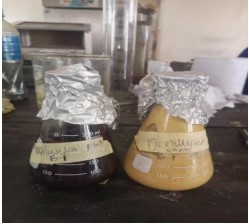
|
| Table 1: | Functions of each material in the formulation | |||
| Materials | Functions |
| Cashew leaf | It contains polyphenols, which reduce interfacial tension |
| Moringa oleifera | It acts as a surface-active compound that reduces surface tension and disrupts interfacial film |
| Liquid soap | It serves as a binder of the formulation of locally sourced materials to bind the lipophilic and the hydrophilic end |
| Paraffin wax | It also serves as a water-repellent |
| Cassava starch | This forms the hydrophilic end of the locally sourced demulsifier because of its strong affinity for water |
| Camphor | It forms a lipophilic end of the local material sourced |
| Sodium hydroxide | It acts as a flocculant |
Performance evaluation: The performance of the formulated demulsifiers was evaluated using the static bottle and dynamic test methods8,9.
Static bottle test: A static bottle test was carried out to determine the efficiency of the demulsifiers at static conditions. The prepared emulsion was properly agitated before being used to achieve proper mixing of the crude and brine solution. During the test, the samples were placed in the water bath to reduce their viscous nature, thereafter, varying samples of the demulsifier were injected into a 12 mL labeled emulsion samples. The centrifuge tube was agitated properly, measurements were taken at 10, 20, 30, 40, 50, and 60 min to determine the amount of oil and water separated from each sample and recorded. The experiment was repeated using different dosages: 0.01, 0.02, 0.03, 0.04, and 0.05 mL, respectively.
Dynamic bottle test: The dynamic bottle test was carried out to measure the efficacy of the demulsifiers to break down the emulsion at dynamic conditions. The procedure entails adding varying quantities of the demulsifiers in the centrifuge tube with 12 mL of the emulsion prepared. Here, the centrifuge machine is connected to a power source, the process was carried out at 500, 1000, 1500, and 2000 rpm, respectively, and results were taken at 10 min intervals while measuring the quantities of separated brine and crude. The experiment was also repeated at different dosages of the demulsifiers: 0.01, 0.02, 0.03, 0.04, and 0.05 mL, respectively.
Statistical analysis: The analysis includes an ANOVA single-factor test performed at a 0.01 mL dosage with a significance level of α = 0.05 to compare the means of three demulsifiers (pt6020, B-1, and C-1). Additionally, a t-test: Paired two sample for means was conducted at the same dosage to assess the performance of pt6020 and B-1, along with Pearson correlation analysis to determine their relationship. These tests were repeated for dosages of 0.02, 0.03, 0.04, and 0.05 mL.
RESULTS AND DISCUSSION
Table 2 shows the viscosity and density of the crude oil sample, the cashew leaf extract (Anacardium occidentale), and the Moringa leaf extract (Moringa oleifera) used for the experiment. From Table 2 it can be seen that the cashew leaf extract is most dense of all the samples while the crude oil is the most viscous compared to Moringa and Cashew leaf extracts.
The rheology of the formulated demulsifiers were shown in Table 3. From Table 3, it could be seen that B-1 was less viscous than C-1 as it attained a reading at 300 and 600 rpm which C-1 could not attain during the test. The viscosity at 300 and 600 rpm of C-1 exceeded the viscometer scale, depicting how viscous the demulsifier was. Both demulsifiers are alkaline in nature with pH readings above 13. The plastic viscosity is for B-1 is 90 rpm.
Figure 2 it could be seen that the best water separation was achieved with the conventional demulsifier at 0.02 mL dosage and this was closely followed by 0.03 mL dosage. The maximum quantity was obtained at 0.02 mL after 60 min of the static bottle test.
Figure 3 shows the performance of the formulated B-1 demulsifier using cashew leaf extract. As it can be seen in Fig. 2, 0.02 mL dosage of the B-1 demulsifier gave the best performance, and there was a progressive performance in breaking the emulsion as time progressed, achieving optimum of water separated after 30 min with 4.8 mL at 0.02 mL dosage. This shows a better performance compared to the conventional demulsifier (pt6020), which at the same time was able to separate only 4.6 mL of water and peaked at 4.9 mL after 60 min.
| Table 2: | Rheological properties of the extracts and the crude oil sample used in this study | |||
| Extracts | Viscosity (cp) | Density (g/cm3) |
| Crude oil | 12 | 0.886 |
| Cashew leaf extract | 2.3 | 0.953 |
| Moringa extract | 2.2 | 0.919 |
| Table 3: | Rheology of the demulsifier B-1 and C-1 | |||
| 300 rpm | 600 rpm | Gel at 10 sec | Gel at 10 min | PH | |
| B-1 | 240 | 330 | 20 | 20 | 13.43 |
| C-1 | - | - | 59 | 60 | 13.63 |
| Cashew leaf (Anacardium occidentale): B-1 and Moringa leaf (Moringa oleifera): C-1 demulsifiers | |||||
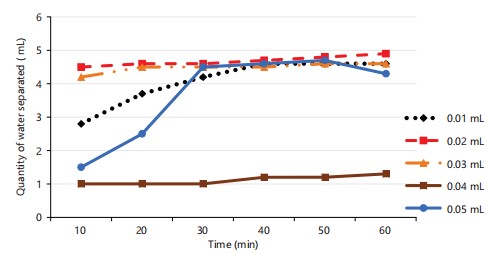
|
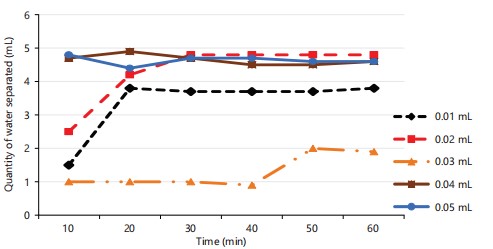
|
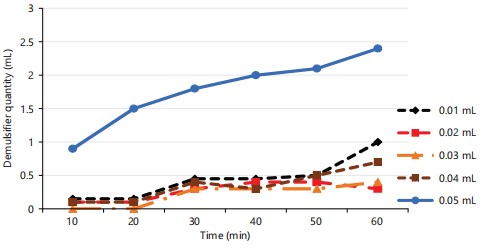
|
The performance of the formulated C-1 demulsifier was very poor during the static bottle test compared to the B-1 and conventional (pt6020) demulsifiers as can be seen volume of water separated in Fig. 3. The best performance was seen at the highest dosage of 0.05 mL where 2.4 mL was only separated after 60 min of the bottle test. Moreover, the fact this was achieved at the highest dosage makes it less attractive as the lower the dosage might be better for a given demulsifier since demulsifiers are generally expensive and prevent demulsifier accumulation effects on the water drop-off13.
In Fig. 4 and 5, increasing the dosage from 0.01 to 0.02 mL increased the volume of water separated for both pt6020 and B-1 demulsifiers14. However, increasing the dosage to 0.03 mL decreased the water separation compared to 0.02 mL. As the dosage increased to 0.04 and 0.05 mL, the performance of pt6020 dropped further while that of B-1 significantly improved as the residence time increased from 10-60 min with a minimum relative percent error of 2%. Again, it could be seen that as the residence time increases, the amount of water separated increases for both pt6020 and B-1 demulsifiers15,16.
Unlike the static bottle test, the dynamic bottle test shows that the conventional demulsifier (pt6020) performed best at 1500 rpm and 0.01 mL dosage, which implies that the demulsifier 9 performs better at higher resolutions and with lower concentration17-19 as shown in Fig. 5. As the concentration increases, the efficiency of the demulsifier decreases20.
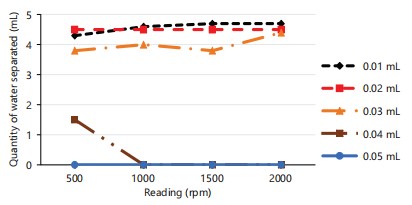
|
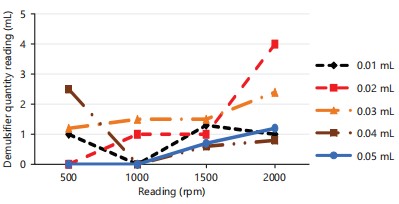
|
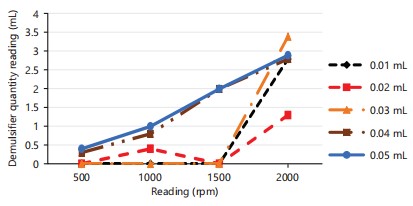
|
As be seen in Fig. 6 and 7, the formulated B-1 and C-1 demulsifiers performed poorly compared to the conventional (pt6020) at dynamic conditions. The maximum water separation was 4 and 3.4 mL at 0.02 mL and 0.03 mL dosages for the B-1 and C-1 demulsifiers at 2000 rpm compared to the conventional demulsifier which separated 4.7 mL at 1500 rpm for a dosage of 0.01 mL.
Figure 8 shows the performance comparison of the different demulsifiers for the bottle test experiment at different demulsifier dosages. Figure 8(a) is for 0.01 mL, Fig. 8(b): 0.02 mL, Fig. 8(c): 0.03 mL,
 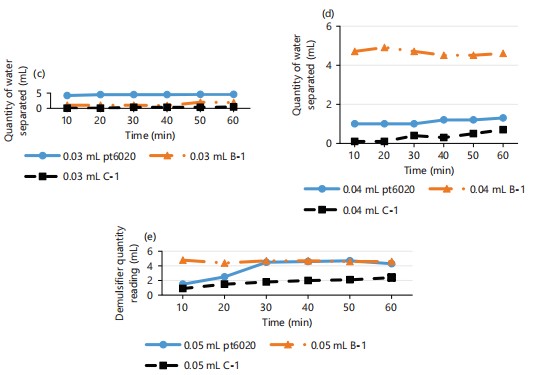
|
Fig. 8(d): 0.04 mL and Fig. 8(e): 0.05 mL, respectively. As it can be seen in Fig. 8, except for the 0.01 and 0.03 dosages, the B-1 performance compared very well with conventional demulsifier. The C-1 shows abysmal performance at all concentrations considered.
Statistical analysis findings: Table 4 shows an Anova single-factor analysis for the three demulsifiers at 0.01 mL dosage at α = 0.05. From the results in Table 4, it can be seen that there is a reasonable difference in the sample means at 4.0833, 3.3667, and 0.45 for pt6020, B-1, and C-1, respectively. Moreover, because Abs(F)>F crit, and the p<0.05, we reject the null hypothesis. Again, the variance of C-1 is far higher compared to pt6020 and B-1, further analysis was focused on comparing performance between pt6020 and B-1.
Table 5 is a t-test, paired two sample for means at 0.01 mL dosage for pt6020 and Anacardium occidentale (B-1) demulsifiers. From Table 5, it can seen that the p-values for a one-tail and two-tail tests (approximately 1%) are less than 5%, implying that the null hypothesis is significant and thus rejected. The Pearson correlation coefficient of 0.85 also shows that a positive correlation exists between the two demulsifiers in resolving oil-in-water emulsions. A similar analysis was done for 0.02, 0.03, 0.04, and 0.05 mL, respectively.
| Table 4: | Anova: Single factor for 0.01 mL dosage | |||
| Groups | Count | Sum | Average | Variance | ||
| Summary | ||||||
| pt6020 | 6 | 24.5 | 4.0833 | 0.5217 | ||
| B-1 | 6 | 20.2 | 3.3667 | 0.8387 | ||
| C-1 | 6 | 2.7 | 0.45 | 0.097 | ||
| ANOVA | ||||||
| Source of variation | SS | df | MS | F | p-value | F-crit |
| Between groups | 44.4433 | 2 | 22.2217 | 45.7445 | 4.13E-07 | 3.6823203 |
| Within groups | 7.2867 | 15 | 0.4858 | |||
| Total | 51.73 | 17 | ||||
| SS: Sum of squares, df: Degrees of freedom, MS: Mean square and F: F-value | ||||||
| Table 5: | t-Test: Paired two sample for means (0.01 mL dosage) | |||
| pt6020 | Anacardium occidentale (B-1) | |
| Mean | 4.0833 | 3.3667 |
| Variance | 0.5217 | 0.8387 |
| Observations | 6 | 6 |
| Pearson correlation | 0.8577 | - |
| Hypothesized mean difference | 0 | - |
| df | 5 | - |
| t-stat | 3.6954 | - |
| P (T<=t) one-tail | 0.007 | - |
| t-critical one-tail | 2.015 | - |
| P (T<=t) two-tail | 0.014 | - |
| t-critical two-tail | 2.5705 | - |
From these analysis, it was observed that except for the 0.05 mL dosage, all other dosages show p-values less than 5%:
| Null | = | Means are equal | |
| Alt | = | Means are not equal | |
| α | = | 0.05 |
CONCLUSION
Two plant-based demulsifiers were formulated using cashew extract (Anarcadium occidentale) B-1, and Moringa leaf extract (Moringa oleifera) C-1 with some additives to resolve water-in-oil emulsion. These green demulsifiers and a conventional chemical-based demulsifier (pt6020) were subjected to static bottle and dynamic tests to determine their effectiveness in resolving water-in-oil emulsion at different demulsifier dosages and rpm for a maximum of 60 min for the static bottle test and 10 min for the dynamic test. The B-1 shows a better prospect as a demuslfier compared to the C-1 and performed better in some cases than the conventional demulsifier (pt6020) considering the volume of water separated. More biodegradable plant extracts are recommended and further investigations should consider the additives that could enhance the performance of the B-1 demulsifier.
SIGNIFICANCE STATEMENT
Following the strong environmental protection and sustainability campaign, efforts are being made to explore green derivatives as substitutes for synthetic and chemical derivatives as oilfield chemicals to solve oilfield water-in-oil emulsion problems. One common oilfield problem that degrades crude oil quality and downgrades its market value is emulsion which is formed when oil combines with water in the presence of an emulsifier and agitation. Thus, this study explores using plant-based demulsifiers as substitutes for chemical demulsifiers. Anacardium occidentale and Moringa oleifera were explored following their unique properties. It was observed that Anacardium occidentale shows a better prospect than Moringa oleifera in resolving water-in-oil emulsion.
REFERENCES
- Schubert, H. and H. Armbruster, 1989. Principles of preparation and stability of emulsions [In German]. Chem. Ing. Tech., 61: 701-711.
- Khan, A.Y., S. Talegaonkar, Z. Iqbal, F.J. Ahmed and R.K. Khar, 2006. Multiple emulsions: An overview. Curr. Drug Delivery, 3: 429-443.
- Hart, A., 2014. A review of technologies for transporting heavy crude oil and bitumen via pipelines. J. Pet. Explor. Prod. Technol., 4: 327-336.
- Sousa, A.M., M.J. Pereira and H.A. Matos, 2022. Oil-in-water and water-in-oil emulsions formation and demulsification. J. Pet. Sci. Eng., 210.
- Abatai, M.C., J.U. Akpabio, A.N. Okon and B.R. Etuk, 2020. Demulsification of crude oil emulsion in well X in a Niger Delta field. Eng. Appl. Sci., 5: 83-91.
- Filho, D.C.M., J.B.V.S. Ramalho, L.S. Spinelli and E.F. Lucas, 2012. Aging of water-in-crude oil emulsions: Effect on water content, droplet size distribution, dynamic viscosity and stability. Colloids Surf. A: Physicochem. Eng. Aspects, 396: 208-212.
- Dhandhi, Y., V. Bhardwaj, R.K. Saw and T.K. Naiya, 2024. Demulsification of water-in-crude oil field emulsion using green demulsifier based on Sesamum indicum: Synthesis, characterization, performance, and mechanism. SPE J., 29: 4166-4178.
- Zolfaghari, R., A. Fakhru’l-Razi, L.C. Abdullah, S.S.E.H. Elnashaie and A. Pendashteh, 2016. Demulsification techniques of water-in-oil and oil-in-water emulsions in petroleum industry. Sep. Purif. Technol., 170: 377-407.
- Raya, S.A., I.M. Saaid, A.A. Ahmed and A.A. Umar, 2020. A critical review of development and demulsification mechanisms of crude oil emulsion in the petroleum industry. J. Pet. Explor. Prod. Technol., 10: 1711-1728.
- Kukizaki, M. and M. Goto, 2009. A comparative study of SPG membrane emulsification in the presence and absence of continuous-phase flow. J. Chem. Eng. Jpn., 42: 520-530.
- Martínez-Palou, R., R. Cerón-Camacho, B. Chávez, A.A. Vallejo and D. Villanueva-Negrete et al., 2013. Demulsification of heavy crude oil-in-water emulsions: A comparative study between microwave and thermal heating. Fuel, 113: 407-414.
- Wen, Y., H. Cheng, L.J. Lu, J. Liu and Y. Feng et al., 2010. Analysis of biological demulsification process of water-in-oil emulsion by Alcaligenes sp. S-XJ-1. Bioresour. Technol., 101: 8315-8322.
- Raynel, G., D.S. Marques, S. Al-Khabaz, M. Al-Thabet and L. Oshinowo, 2021. A new method to select demulsifiers and optimize dosage at wet crude oil separation facilities. Oil Gas Sci. Technol. Rev. IFP Energies Nouvelles, 76.
- Wang, D., D. Yang, C. Huang, Y. Huang and D. Yang et al., 2021. Stabilization mechanism and chemical demulsification of water-in-oil and oil-in-water emulsions in petroleum industry: A review. Fuel, 286.
- Grenoble, Z. and S. Trabelsi, 2018. Mechanisms, performance optimization and new developments in demulsification processes for oil and gas applications. Adv. Colloid Interface Sci., 260: 32-45.
- Ndubuisi, E., L. Ikeh, I. Emeka and S. Mofunlewi, 2023. Efficacy of a locally formulated demulsifier in the treatment of crude oil emulsions. IOSR J. Eng., 13: 8-17.
- Udonne, J.D., 2012. Chemical treatment of emulsion problem in crude oil production. J. Pet. Gas Eng., 3: 135-141.
- Georgewill, A. and A. Joseph, 2023. Utilization of plant extract for treatment of emulsions in crude oil production. Appl. Sci. Res. Periodicals, 1: 69-92.
- Amajuonyi, P., P.C. Azubuike, C.C. Omaka, N.D. Enyioko and A.O. Chikwe, 2019. Formulation of demulsifying agent for water in oil emulsion treatment. Int. J. Innovative Res. Dev., 8: 207-214.
- Alao, K.T., O.R. Alara and N.H. Abdurahman, 2021. Trending approaches on demulsification of crude oil in the petroleum industry. Appl. Petrochem. Res., 11: 281-293.
How to Cite this paper?
APA-7 Style
Obomanu,
T., Joseph,
A., Godson,
C.C. (2025). Effective Separation and Hydrocarbon Accounting in Water-in-Oil Emulsion Through Demulsification Using Formulated Plant Extracts. Trends in Applied Sciences Research, 20(1), 14-23. https://doi.org/10.3923/tasr.2025.14.23
ACS Style
Obomanu,
T.; Joseph,
A.; Godson,
C.C. Effective Separation and Hydrocarbon Accounting in Water-in-Oil Emulsion Through Demulsification Using Formulated Plant Extracts. Trends Appl. Sci. Res 2025, 20, 14-23. https://doi.org/10.3923/tasr.2025.14.23
AMA Style
Obomanu
T, Joseph
A, Godson
CC. Effective Separation and Hydrocarbon Accounting in Water-in-Oil Emulsion Through Demulsification Using Formulated Plant Extracts. Trends in Applied Sciences Research. 2025; 20(1): 14-23. https://doi.org/10.3923/tasr.2025.14.23
Chicago/Turabian Style
Obomanu, Tamunotonjo, Amieibibama Joseph, and Chukwu Chimarouke Godson.
2025. "Effective Separation and Hydrocarbon Accounting in Water-in-Oil Emulsion Through Demulsification Using Formulated Plant Extracts" Trends in Applied Sciences Research 20, no. 1: 14-23. https://doi.org/10.3923/tasr.2025.14.23

This work is licensed under a Creative Commons Attribution 4.0 International License.



